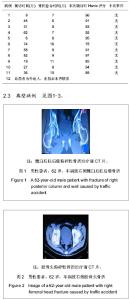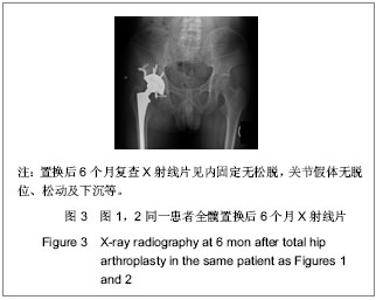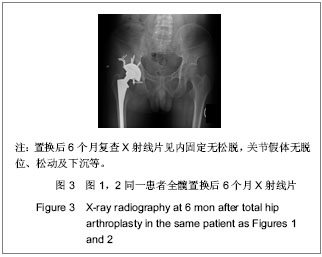| [1] 汤宇,孙天胜.特殊类型的髋关节置换及其功能重建[J].中国临床康复,2005;9(34):130-131.
[2] Letournel E. Acetabulum fractures: classification and management. Clin Orthop Relat Res. 1980;151: 81-106.
[3] Harris WH. Traumatic arthritis of the hip after dislocation and acetabular fractures:treatment by mold arthroplasty. An end-result study using a new method of result evaluation. J Bone Joint Surg Am. 1969;51(4):737-755.
[4] Joly JM, Mears DC. The role of total hip arthroplasty in acetabular fracture management. Operat Techn Orthop. 1993; 3(1):80-102.
[5] 孙红振,王子明,王爱民,等.I期全髋关节置换治疗髋臼骨折[J].中华创伤杂志,2008,24(12):982-984.
[6] Duygulu F, Calis M, Argun M, et al. Unusual combination of femoral head dislocation associated acetabular fracture with ipsilateral neck and shaft fractures: A case report. J Trauma. 2006;61(6):1545.
[7] 张国如,王体沛,陈锡森.移位髋臼骨折的手术治疗[J].中华创伤杂志,2010,26(3): 244-247.
[8] 高洪,罗从风,胡承方,等.透视导航下经皮螺钉置入内固定髋臼骨折18例[J].中国组织工程研究与临床康复,2010,14(17): 3201-3204.
[9] 程玉庆,程学福,姜建军.髋臼骨折的手术治疗[J].临床骨科杂志, 2012,15(3):282-286.
[10] 张震.髋臼骨折的手术治疗[J].中国骨与关节外科,2010,3(5): 398-400.
[11] 梁杰,武斌,李玉鹏.髋臼骨折的手术治疗[J].中国医师进修杂志, 2011,34(5):23-25.
[12] 张育锋,钟志刚,邱雪立,等.移位髋臼骨折手术治疗技巧探讨[J].中华创伤杂志,2010,26(3):244-247.
[13] Mohanty K,Taha W,Powell JN.Non-union of acetabular fractures. Injury. 2004;35(8):787-790.
[14] 于平,李喜柱,贺挺勇.手术治疗有移位髋臼骨折36例分析[J].中国药物与临床, 2012,12(8):1080-1082.
[15] 张光耀.复杂髋臼骨折的手术治疗[J].临床误诊误治,2010,23(11): 1057-1058.
[16] 冯勇,杨述华,许伟华,等.髋臼骨折治疗失败的原因分析及挽救性全髋置换[J].中华创伤杂志,2010,26(9):843-844.
[17] Jimenez ML,Tile M.Total hip replacement after acetabular fracture. Othop Clin North Am. 1997;28(3):435-446.
[18] Mears DC,Velyvis JH.Primary total hip arthroplasty after acetabular fracture. Instr Coures Lect. 2001 ;50:335-354.
[19] Hoellen IP,Mentzel M,Bischoff M,et al.Acetabular fractures in elderly persons.Primary endoprosthetic treatment. Orthopede. 1997;26(4):348-353.
[20] Mears DC,Velyvis JH,Ching CP.Displaced acetabular fractures managed operatively:indicators of outcome. Clin Orthop Relat Res. 2003;407(2):173-186.
[21] 关群,熊小江,冯世龙,等.移位髋臼骨折的手术治疗[J].中华创伤杂志,2007, 23(7): 489-492.
[22] 陈志文,翟文亮,丁真奇,等.一期人工全髋关节置换治疗中老年PipkinⅣ型股骨头骨折[J].临床骨科杂志,2011,14(4):389-391.
[23] 唐孝明,张耀明,袁加斌,等.I期全髋置换术治疗合并股骨头或股骨颈骨折的髋臼骨折[J].中华创伤杂志,2008,24(12):975-977.
[24] Mears DC,Velyvis JH.Acute total hip arthroplasty for selected displaced acetabular fractures:two to twelve year results.J Bone Joint Surg(Am). 2002;84(1):1-9.
[25] Guerado E, Cano JR, Cruz E. Fractures of the acetabulum in elderly patients: An update. Injury. 2012;43: S33-S41.
[26] 唐佩福,王岩,李静东,等.全髋关节置换术治疗髋臼骨折[J].中国矫形外科志,2005,13(6):407-410.
[27] Mouhsine E, Garofalo R, Borens O, et al. Acute total hip arthroplasty for acetabular fractures in the elderly:11 patients followed for 2 years.Acta Orthopaedica. 2002;73(6):615-618.
[28] Schreurs B W, Zengerink M, Marianne L M, et al.Bone impaction grafting and a cemented cup after acetabular fracture at 3-18 years.Clin Orthop Relat Res. 2005;437: 145-151.
[29] Haidukewych GJ. Acetabular fractures: the role of arthroplasty. Orthopedics.2010;33(9):645.
[30] 唐佩福,王岩.髋臼骨折后行全髋关节置换的手术策略[J]. 中国骨与关节损伤杂志,2005,20(7):502-504.
[31] Weber M,Berry DJ,Harmsen WS.Total hip arthroplasty after operative treatment of an acetabular fracture.J Bone Joint Surg(Am). 1998;80(9):1295-1305.
[32] Romness DW, Lewallen DG. Total hip arthroplasty after fracture of the acetabulum.Long-term results. J Bone Joint Surg Br. 1990;72(5):761-764.
[33] Sermon A,Broos P,Vanderschot P. Total hip replacement for acetabular Fractures:Results in 121 patients operated between 1983 and 2003.Injury. 2008;39(8):914-921.
[34] 杨述华.叶哲伟,许伟华,等. 严重髋臼骨折早期全髋置换术效果观察[J].创伤外科杂志,2006, 8(2):133-135.
[35] 吴坚,褚亚明,陶秀娣,等. 人工全髋关节置换术后复发性脱位的外科处理和临床结果[J].中华外科杂志,2012,50(5):407-412.
[36] 王微慎,周建生.人工髋关节置换术后感染的一期翻修手术治疗[J].解剖与临床, 2011,16(4):282-285.
[37] 沈灏,王俏杰,张先龙,等.非骨水泥假体二期翻修治疗慢性人工全髋关节置换术后感染[J].中华外科杂志,2012,50(5):402-406.
[38] 赵光荣,兰秀夫.全髋关节置换术后股骨假体周围骨折的治疗[J].创伤外科杂志, 2010,12(3):234-237.
[39] 王建生,高兆宾,王志强.髋关节置换术后发生非感染性骨缺损原因的研究进展 [J].中华刨伤骨科杂志,2010,12(3):278-280.
[40] 吴新宝,杨明辉,王满宜,等. 髋臼骨折术后异位骨化的手术治疗[J].中华外科杂志,2008,46(7):506-509. |



